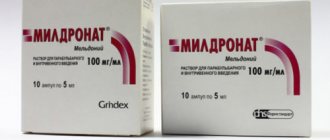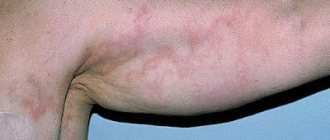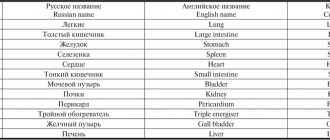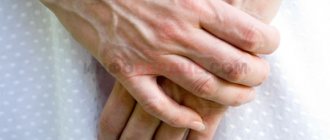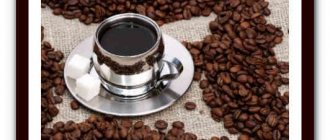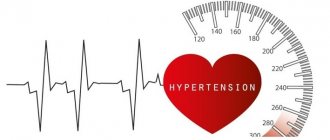Vegetovascular dystonia (VSD) is a syndrome that manifests itself as a violation of the autonomic function of the central nervous system. Its cause is various diseases of the circulatory or central nervous system, endocrine and other pathologies. Despite the fact that VSD is not included in the ICD (International Classification of Diseases), many doctors continue to use this term for convenience. Mexidol for vegetative-vascular dystonia can be used as the main or symptomatic method of treatment. It belongs to the group of antioxidants, and its action is aimed at restoring cerebral blood supply.
Mexidol injections for VSD. The whole truth about the drug!
Mexidol is a Russian medicine with a complex mechanism of action, which is used for pathologies of the nervous and cardiovascular systems, visual impairment, and long-term stress.
Brief description of Mexidol
The active ingredient of Mexidol is ethylmethylhydroxypyridine succinate. It is characterized by a combined effect on the body:
- neutralizes reactive oxygen species - free radicals - that destroy cell membranes;
- stimulates the production of large amounts of energy;
- accelerates the conduction of nervous stimulation through nerves and brain cells (neurons);
- neutralizes the toxic effects on the body of alcohol-containing drinks and antipsychotics (neuroleptics);
- increases the survival of body cells under stressful conditions;
- calms, relieves anxiety, normalizes sleep;
- increases blood fluidity, prevents thrombosis;
- improves metabolism in the heart muscle.
The product is available in the form of tablets of 125 mg and in the form of a 5% solution in 2 and 5 ml ampoules. The solution can be placed into the muscle and intravenously - drip or stream.
Mexidol for VSD
The autonomic nervous system is responsible for regulating the functioning of internal organs. It consists of 2 departments: sympathetic and parasympathetic.
The sympathetic nervous system increases blood pressure, increases heart rate, and reduces the activity of the digestive tract.
The parasympathetic system has the opposite functions - slowing down the heart rate, lowering blood pressure, stimulating the gastrointestinal tract. Normally, both of these departments are in balance; if one predominates, then only slightly.
Against the background of stress, overwork, and psychological experiences, the balance between the sympathetic and parasympathetic systems is disrupted. A condition develops that is called vegetative-vascular dystonia (VSD). Depending on the prevailing symptoms, there are several options:
- hypertensive type (with increased blood pressure);
- hypotonic type (with a decrease in pressure);
- cardiac type (with heart rhythm disturbances);
- mixed type (combination of several symptoms).
A common symptom of VSD is panic attacks - attacks of unmotivated fear.
One of the properties of Mexidol is the ability to regulate the functioning of the autonomic nervous system. Regardless of the form of the disorder, the drug restores balance and eliminates the manifestations of VSD. Thanks to its anti-anxiety effect, Mexidol successfully fights panic attacks.
In addition, if you are prone to dystonia, the medicine can be injected or taken in tablets as a prophylactic against the background of stress, insomnia and overwork.
If the patient does not have the opportunity to give injections in the evening, then the second injection is allowed to be replaced by taking a pill. This course of treatment usually lasts 10-15 days, and then it is recommended to switch to the tablet form: 1 tablet 2-3 times a day.
The dosage depends on the severity of symptoms and tolerability of Mexidol. Tablets are usually recommended to be taken for at least a month.
The drug is often prescribed in conjunction with other medications (Cortexin, Phenibut and Actovegin) or with non-drug treatment (psychotherapy, reflexology).
The mechanism of action of the drug in VSD
Vegetative-vascular dystonia can manifest itself constantly or episodically. During these periods, the patient complains of general weakness and malaise, headaches and dizziness, fever, insomnia, a feeling of lack of air or panic attacks. Other manifestations of VSD include trembling and numbness of the limbs, as well as coldness. All these signs are associated with insufficient oxygen supply to the brain, which affects the innervation of the limbs and internal organs.
Mexidol has a number of positive effects for VSD:
- strengthens brain cells and prevents their destruction;
- normalizes blood flow in the central nervous system and distal limbs;
- has a calming effect and relieves signs of neuroses;
- activates energy production processes for normal brain function under hypoxic conditions;
- relieves headaches, restores strength and performance.
There is a classification that identifies several types of vegetative-vascular dystonia. Mexidol will be effective for each of them. Since it acts at the cellular level and affects the mechanism of disease development, after a course of taking it it is possible to stop all possible causes of VSD. The effectiveness of the drug depends on the severity of clinical signs, cause and severity of the disease.
Instructions and dosages
How to properly inject Mexidol injections
Mexidol is produced in two main forms: tablets and solution for injection. The tablets contain 125 mg of active ingredient and are sold in packages with contour cells of 10 pieces. The solution is contained in ampoules of 5 ml, each containing 50 mg of the active substance. The duration of treatment with this drug and dosage are selected individually, depending on the cause and severity of the disease.
| Diagnosis | Mexidol form | Dosage per day | Course duration |
| Treatment of mild traumatic brain injuries and their consequences | Pills | Up to 800 mg, 125-250 mg per dose | From several days to several months |
| Poor circulation in the brain | Injections at the end of the course can be replaced with tablets | In the first 3 days - 300 ml drip, then 100 per day intramuscularly | Up to 2 weeks |
| Withdrawal syndrome | Pills | 250 mg (2 tablets) 2 times a day | No more than 1 week |
| Encephalopathies | Injections | Up to 500 ml, divided into 2 procedures, administered intravenously | Up to 2 weeks |
| Intoxication | Injections | Up to 500 ml per day intravenously, divide the dose into 2 doses | 1-2 weeks |
The tablets should be taken after meals and washed down with water. The daily dose should be divided into 2-3 doses. The drug is indicated for the relief of acute attacks of VSD and is prescribed according to indications. However, it can also be taken to prevent another relapse if the patient’s relapse is related to weather conditions. Most often they occur in spring and autumn.
REFERENCE! Mexidol for VSD is often used in tablet form. However, during acute attacks of the disease, if they are associated with organic brain damage and impaired brain activity, a course of injections may be required.
The active ingredients of the drug restore cell walls and normalize blood circulation in the brain
Features of the treatment of vegetative-vascular dystonia
Treatment of VSD is complex and selected individually, depending on test results. However, some drugs, including Mexidol, can be prescribed for any form of this disease. When the blood supply to the brain is disrupted and nerve conduction deteriorates, the strength of cell walls decreases. Antioxidant drugs strengthen membranes and normalize blood circulation in the central nervous system.
Antioxidants are substances and medications that can influence lipid peroxidation reactions. These processes are dangerous for the body and occur with the participation of normal cells and free radicals - any substances that can affect metabolic reactions and destroy cell membranes. The human body has its own antioxidants, but if they are present in insufficient quantities, their supply must be replenished with special preparations.
REFERENCE! The action of antioxidants is not directed. They influence the processes of lipid peroxidation, which occur in any organ with the participation of specific and nonspecific cells.
The drug is most often prescribed in tablet form, but injections may be required to relieve acute attacks of VSD
What is the result of taking Mexidol for VSD?
Mexidol: cheap analogues and substitutes, prices for Russian and foreign drugs in tablets and ampoules
I would like to note right away that there are a lot of positive reviews on Mexidol on the Internet. Moreover, it is taken to a greater extent by people suffering from vegetative-vascular dystonia, panic attacks, and neuroses.
If you suffer from VSD, then you probably know that the symptoms are very varied and it is very difficult to track the effect of such drugs on them. In addition, Mexidol is not a healing drug, it is not even a nootropic.
I took it along with the prescribed Piracetam and Phenibut. Therefore, it is extremely difficult for me to say about the effect of Mexidol alone on VSD. But as far as I know, it is most effective in complex therapy. But as an independent remedy for acute neuroses, it is very weak and is not able to stop panic attacks. It is also known that in particularly acute conditions, Mexidol injections act much faster and more effectively than tablets.
The prescribed complex therapy significantly improved my condition.
I had more energy, my mood began to improve, and my anxiety level decreased. At that time, I already knew what was wrong with me, and I coped well with PA. However, they still appeared. These medications do not eliminate panic attacks, but they do reduce them. Self-psychotherapy helped me completely cope with PA.
The most basic and obvious effect that I received from Mexidol in complex therapy was that my migraine headaches significantly decreased. Before this they occurred very often and were quite strong. After a course of medication, I felt how wonderful it was to live without headaches. From that moment to this day, I have had headaches very rarely, compared to what I had before.
I didn't notice any other special effects.
Since the cause of neurosis lies precisely in the psyche, such drugs cannot completely get rid of the problem. But they are able to support the autonomic system and improve physical condition. Mexidol definitely won’t be superfluous for VSD, but you shouldn’t expect miracles from it either.
What are the features of panic attacks during pregnancy?
Pregnancy is a complex physiological process associated with conception, gestation and birth of a child. At this time, the woman’s body undergoes significant hormonal changes, which are repeated and have their own characteristics in the early, middle and late stages of pregnancy. Panic attacks during pregnancy pose a threat to the health of the woman herself and her fetus. Most often they appear in women who were diagnosed before pregnancy, but may appear for the first time during this period. There are quite objective reasons for the occurrence of panic attacks during pregnancy - these are an increased level of anxiety in connection with the upcoming birth, fears about the course of pregnancy and its premature termination, the condition of the fetus, the presence of genetic abnormalities, fear of the future, especially if there are problems with husband, housing, work, etc.
Factors contributing to the development of panic attacks during pregnancy may be: • Sleep disturbance and fatigue. • Organic diseases and reduced immunity. • Difficult pregnancy with severe early and/or late toxicosis. • Endocrine disorders, especially thyroid function. • Problems at work, poor psychological and social conditions. • Perfectionism, the desire for ideal order and the desire to keep everything under control.
The excessive release of adrenaline observed during PA can harm a woman’s body, which is especially vulnerable during pregnancy, and in some cases even result in a miscarriage. Therefore, even isolated PAs cannot be ignored and you must definitely tell the pregnancy specialist about them. If a woman has already encountered PA before and has undergone treatment from a psychotherapist, then during pregnancy she must definitely consult with him and seek help at the slightest sign of their resumption.
It is very difficult for a pregnant woman to cope with panic attacks on her own; she needs the help and support of others: • First, breathing should be normalized. Breathing on a count or into a paper bag will do. • Secondly, you need to distract the pregnant woman's attention by inviting her to count to 100, take a shower, or eat something tasty. You can stroke the belly, hug, caress; tactile sensations in terms of switching attention are especially effective for women.
A logical question is, if all these techniques turned out to be ineffective in getting rid of panic attacks during pregnancy, what to do? After all, tranquilizers and antidepressants cannot be taken during pregnancy, especially in the first trimester, but what would you do without them? Here, psychotherapy sessions and the prevention of attacks come first, namely: • Exclusion of places and situations where PA is most likely. This could be a crowd or a confined space, discussions with friends about their unsuccessful pregnancies and “terribly difficult” births, various negative “readings” on the Internet about possible complications during pregnancy and their danger to the fetus. You should not increase your level of anxiety, it is better to think positively, because it is not without reason that they say that thoughts often acquire their real embodiment. • Walks in the fresh air, especially before bedtime, lasting at least half an hour. This evening exercise will promote better sleep. • Moderate physical activity. You can do breathing yoga, meditation exercises, swimming, group classes for pregnant women, or at least do a simple morning exercise of several easy exercises. • Peripheral vision training. Oddly enough, but this helps to switch attention faster. As for sessions with a psychotherapist, they will help to identify the root cause of PA, select the optimal treatment method in order to reduce general anxiety and prevent panic attacks. Cognitive behavioral therapy and hypnotherapy are quite effective. During the sessions, negative attitudes are replaced with positive ones, self-esteem and self-confidence increase, relaxation techniques are mastered, and control over thoughts and emotions is established. As a result, the frequency and intensity of panic attacks gradually decreases, and then the attacks stop completely. Sometimes just a few sessions of psychotherapy are enough for this.
Indications for the drug Mexidol
Duration of treatment with Mexidol
consequences of acute cerebrovascular accidents, incl. after transient ischemic attacks, in the subcompensation phase as preventive courses;
mild traumatic brain injury, consequences of traumatic brain injury;
encephalopathies of various origins (dyscirculatory, dysmetabolic, post-traumatic, mixed);
autonomic dystonia syndrome;
mild cognitive disorders of atherosclerotic origin;
anxiety disorders in neurotic and neurosis-like conditions;
coronary heart disease (as part of complex therapy);
relief of withdrawal syndrome in alcoholism with a predominance of neurosis-like and vegetative-vascular disorders, post-withdrawal disorders;
conditions after acute intoxication with antipsychotic drugs;
prevention of the development of somatic diseases under the influence of extreme factors and stress;
exposure to extreme (stress) factors.
Indications for use
Since Mexidol has a complex effect on the human body, it is prescribed for many different pathologies. Most often, indications for its use are disorders of the brain and cardiovascular system. Phenomena in which this drug has a positive therapeutic effect include:
- acute cerebrovascular accidents and their consequences, including after attacks of ischemia;
- traumatic brain injuries and the rehabilitation period after them;
- encephalopathy of any origin;
- disorders of the nervous system associated with atherosclerosis;
- vegetative-vascular dystonia;
- anxiety states and sleep disorders caused by neuroses;
- withdrawal syndrome in chronic alcoholism;
- relief of conditions after acute intoxication with medications (usually antipsychotic drugs), various neurotropic poisons;
- stressful situations that manifest themselves as disturbances in the functioning of the autonomic nervous system.
IMPORTANT! Despite the fact that Mexidol has a positive effect on the human body, it should be taken only when indicated. Like any other medicine, it has contraindications and can cause side effects.
The main symptoms of VSD are headaches and dizziness, but it can have individual manifestations in different people.
Description of the drug Mexidol
Determining the exact classification of the drug Mexidol is quite problematic. The fact is that this remedy is capable of providing various therapeutic effects and influencing different systems of the human body. The drug Mexidol belongs to several pharmacological groups. It can be attributed to medications that have a positive effect on the cardiovascular system in VSD. Mexidol also refers to medications that act mainly on the cerebral vascular system. At the same time, Mexidol is a type of antioxidant.
There are several options for the effect of Mexidol on the human body. Thanks to the effect of the active substance of the drug, which is ethylmethylhydroxypyridine succinate, there is a positive effect on the manifestation of the following effects:
- antioxidant;
- antihypoxic;
- neuroprotective.
The drug Mexidol is a powerful antioxidant. From which we can conclude that when taken, lipid peroxidation is blocked, as a result of which cell membranes are normalized. The drug Mexidol is able to protect cells of internal organs during VSD. The positive effect of the drug is aimed at protecting liver and brain cells.
The antihypoxic effect is understood as an increase in the body’s ability to be stable at low oxygen levels in the blood as a result of the use of Mexidol
This is very important in the treatment of VSD accompanied by hypoxia. A short-term reduction in the need for oxygen helps to increase the stress resistance of the human body
The lipid-lowering effect of Mexidol is an excellent prevention of atherosclerosis in VSD. It is noted that this drug to some extent contributes to blood thinning during VSD.
The manifestation of a mild anxiolytic effect of Mexidol contributes to the additional suppression of emerging stress conditions during VSD. Experts note that when Mexidol is taken in combination with tranquilizers, antipsychotics, and antidepressants, an enhanced effect of all drugs for the treatment of VSD is observed.
Composition and description of the drug
Mexidol is a complex action drug that is widely used for vegetative-vascular dystonia. The drug belongs to the groups of free radical oxidation inhibitors, membrane protectors, nootropics, antihypoxic and anti-stress drugs. It improves nutrition and blood supply to the brain, and also reduces the body's sensitivity to hypoxia. The main active ingredient of this medicine is ethylmethylhydroxypyridoxine succinate.
In the human body, Mexidol acts as follows:
- enhances the activity of membrane enzymes, which leads to an increase in their strength and elasticity;
- increases the amount of dopamine in the brain - this leads to an acceleration of the processes of anaerobic glycolysis, which occur under conditions of hypoxia (insufficient oxygen supply) with the production of energy;
- improves the chemical properties of blood, which improves blood circulation in the central nervous system and prevents thrombosis;
- strengthens blood cell membranes;
- restores the functioning of the nervous system during periods of stress, normalizes sleep and prevents dystrophy of certain areas of the brain;
- promotes the elimination of toxins and metabolic products of certain medications;
- normalizes cardiac activity during ischemia.
All such effects affect the patient's condition. As a result of taking the drug, the functioning of the central nervous system and myocardium improves, blood vessels are strengthened and the composition of the blood improves. Thus, all cells of the body receive a sufficient amount of oxygen and nutrients, which produces energy for their normal functioning. The risk of blood clots, the main cause of myocardial infarction, is also reduced. The effect of Mexidol is especially noticeable under conditions of hypoxia, that is, when the supply of oxygen to individual organs and tissues is disrupted.
Pharmacodynamics
Mexidol is an inhibitor of free radical processes, a membrane protector with antihypoxic, stress-protective, nootropic, anticonvulsant and anxiolytic effects.
The drug increases the body's resistance to the effects of various damaging factors (shock, hypoxia and ischemia, cerebrovascular accidents, intoxication with alcohol and antipsychotics - antipsychotics).
The mechanism of action of the drug Mexidol is due to its antioxidant, antihypoxic and membrane protective effects. It inhibits lipid peroxidation, increases the activity of superoxide dismutase, increases the lipid-protein ratio, reduces membrane viscosity, and increases its fluidity.
Mexidol modulates the activity of membrane-bound enzymes (calcium-independent PDE, adenylate cyclase, acetylcholinesterase), receptor complexes (benzodiazepine, GABA, acetylcholine), which enhances their ability to bind to ligands, helps preserve the structural and functional organization of biomembranes, transport of neurotransmitters and improve synaptic transmission.
Mexidol increases the content of dopamine in the brain. Causes an increase in compensatory activation of aerobic glycolysis and a decrease in the degree of inhibition of oxidative processes in the Krebs cycle under hypoxic conditions with an increase in the content of ATP and creatine phosphate, activation of the energy-synthesizing functions of mitochondria, stabilization of cell membranes.
The drug improves metabolism and blood supply to the brain, improves microcirculation and rheological properties of blood, and reduces platelet aggregation.
Stabilizes the membrane structures of blood cells (erythrocytes and platelets) during hemolysis. It has a hypolipidemic effect, reduces the content of total cholesterol and LDL.
The anti-stress effect is manifested in the normalization of post-stress behavior, somatovegetative disorders, restoration of sleep-wake cycles, impaired learning and memory processes, reduction of dystrophic and morphological changes in various structures of the brain.
Mexidol has a pronounced antitoxic effect in withdrawal symptoms. It eliminates the neurological and neurotoxic manifestations of acute alcohol intoxication, restores behavioral disorders, autonomic functions, and is also able to relieve cognitive impairment caused by long-term use of ethanol and its withdrawal.
Under the influence of the drug Mexidol, the effect of tranquilizing, neuroleptic, antidepressant, hypnotics and anticonvulsants is enhanced, which makes it possible to reduce their doses and reduce side effects.
Mexidol improves the functional state of ischemic myocardium. In conditions of coronary insufficiency, it increases collateral blood supply to the ischemic myocardium, helps maintain the integrity of cardiomyocytes and maintain their functional activity. Effectively restores myocardial contractility in reversible cardiac dysfunction.
Compatibility and interaction with other drugs
This drug is compatible with many drugs, thereby increasing the effectiveness of therapy. Mexidol can enhance the effect of benzodiazepines, carbamazepine, anticonvulsants and tranquilizers.
There are also studies of the interaction of Mexidol with certain types of drugs, such as:
This medicine is in many ways similar to Mexidol and, as a rule, is prescribed together. actovegin, due to the nature of its main component (calf blood), allergic reactions occur more often. However, Actovegin is able to improve the metabolic process of tissues and their regeneration, which Mexidol cannot do.
This drug has a vasodilating effect and is used for circulatory disorders. It also has a mild therapeutic effect in lowering blood pressure. Cavinton and Mexidol interact well with each other and are very often used together, but the drug is not mixed, but administered separately.
In combination with this drug, Mexidol is used in the treatment of oxygen starvation in infants.
The familiar drug has a vasodilating effect and supplies the brain tissue with the necessary oxygen. Prescribed for ischemia. Combined use with Mexidol is used for withdrawal syndrome and pathological blood circulation in the brain.
Mexidol for VSD
The autonomic nervous system is responsible for regulating the functioning of internal organs. It consists of 2 departments: sympathetic and parasympathetic. The sympathetic nervous system increases blood pressure, increases heart rate, and reduces the activity of the digestive tract. The parasympathetic system has the opposite functions - slowing down the heart rate, lowering blood pressure, stimulating the gastrointestinal tract. Normally, both of these departments are in balance; if one predominates, then only slightly.
Against the background of stress, overwork, and psychological experiences, the balance between the sympathetic and parasympathetic systems is disrupted. A condition develops that is called vegetative-vascular dystonia (VSD). Depending on the prevailing symptoms, there are several options:
- hypertensive type (with increased blood pressure);
- hypotonic type (with a decrease in pressure);
- cardiac type (with heart rhythm disturbances);
- mixed type (combination of several symptoms).
A common symptom of VSD is panic attacks - attacks of unmotivated fear.
One of the properties of Mexidol is the ability to regulate the functioning of the autonomic nervous system. Regardless of the form of the disorder, the drug restores balance and eliminates the manifestations of VSD. Thanks to its anti-anxiety effect, Mexidol successfully fights panic attacks.
In addition, if you are prone to dystonia, the medicine can be injected or taken in tablets as a prophylactic against the background of stress, insomnia and overwork.
For frequent attacks of VSD, Mexidol is used in injections or droppers. Usually, 2 ml of the drug is prescribed intramuscularly 2 times a day or 5 ml intravenously by drip or stream also twice a day. If the patient does not have the opportunity to give injections in the evening, then the second injection is allowed to be replaced by taking a pill. This course of treatment usually lasts 10-15 days, and then it is recommended to switch to the tablet form: 1 tablet 2-3 times a day. The dosage depends on the severity of symptoms and tolerability of Mexidol. Tablets are usually recommended to be taken for at least a month.
The drug is often prescribed in conjunction with other medications (Cortexin, Phenibut and Actovegin) or with non-drug treatment (psychotherapy, reflexology).
What types of panic attacks are the most common?
Some authors call a panic attack an emergency mode of its functioning triggered by the body’s SOS command, others call it a hysteria of the body, and others call it a vegetative storm. In my opinion, the previously defined definition of PA as a sympathoadrenal crisis, in contrast to the term episodic paroxysmal anxiety currently accepted in the international medical classification, most accurately reflects what is happening.
The symptoms and characteristics of PA manifest themselves differently depending on the time and conditions of the onset of attacks, the state of the hormonal system, age and gender.
Depending on the conditions of occurrence, panic attacks are: • Spontaneous, occurring completely unexpectedly and without reference to an apparent reason. • Situational, which is the body’s response to a specific disturbing or frightening situation. For example, anxiety before an entrance exam, an important interview, or a showdown with an unfriendly person can provoke a situational panic attack. • Conditional-situational. This is a special type of PA, tied to one stimulus, most often of a chemical or biological nature. An example would be PA due to alcohol consumption or a large number of caffeine-containing drinks.
Many PAs develop under certain physiological conditions of the body, for example, panic attacks at night or during sleep, in childhood or during pregnancy, there is a type of panic attacks with cervical osteochondrosis. Today I will try to talk in more detail about these special cases.
Instructions and dosages
Mexidol is produced in two main forms: tablets and solution for injection. The tablets contain 125 mg of active ingredient and are sold in packages with contour cells of 10 pieces. The solution is contained in ampoules of 5 ml, each containing 50 mg of the active substance. The duration of treatment with this drug and dosage are selected individually, depending on the cause and severity of the disease.
| Diagnosis | Mexidol form | Dosage per day | Course duration |
| Treatment of mild traumatic brain injuries and their consequences | Pills | Up to 800 mg, 125-250 mg per dose | From several days to several months |
| Poor circulation in the brain | Injections at the end of the course can be replaced with tablets | In the first 3 days - 300 ml drip, then 100 per day intramuscularly | Up to 2 weeks |
| Withdrawal syndrome | Pills | 250 mg (2 tablets) 2 times a day | No more than 1 week |
| Encephalopathies | Injections | Up to 500 ml, divided into 2 procedures, administered intravenously | Up to 2 weeks |
| Intoxication | Injections | Up to 500 ml per day intravenously, divide the dose into 2 doses | 1-2 weeks |
REFERENCE! Mexidol for VSD is often used in tablet form. However, during acute attacks of the disease, if they are associated with organic brain damage and impaired brain activity, a course of injections may be required.
The active ingredients of the drug restore cell walls and normalize blood circulation in the brain
Reviews about the product
Elena, 32 years old I was diagnosed with VSD as a teenager, and I would like to leave a review about the drug Mexidol. The doctor prescribed it to me in tablets, I took 2 tablets a day for 2 weeks. During this time, improvements became clearly visible. Headaches disappeared, strength for work and rest appeared, sleep was restored. The treatment will have to be repeated periodically, of course, but I am satisfied with the result.
Igor, 36 years old I began to experience symptoms of VSD after a traumatic brain injury. There were sudden dizziness to the point of loss of consciousness, constant migraines. This did not happen constantly, but in attacks, that is, basically these signs were absent. Once again I went for an examination and was prescribed Mexidol. Instead of having headaches for a week at a time, as was the case before, I can now get rid of them in a couple of days. Good product, I recommend it.
Analogs
In most cases, the drug is well tolerated, but if for some reason its use is impossible, the doctor selects another remedy. In pharmacies you can find a lot of analogues, domestic and foreign, cheap and not so cheap. They also come in various forms.
In terms of composition and pharmacological action, Mexidol can be replaced with the following drugs.
| Product name | Price, rub . |
| "Mexico" | 230 |
| Astrox | 310 |
| "Cericard" | 240 |
| "Medomexy" | 220 |
On the domestic market, you can often find cheaper analogues of Mexidol, which have a different chemical composition, but the same principle of influence on the body. They are also available in tablets and ampoules.
| Product name | Price, rub. |
| "Actovegin" | 1020 |
| "Glycine" | 95 |
| "Nootropil" | 280 |
| "Instenon" | 265 |
| "Cortexin" | 920 |
| "Cavinton" | 360 |
| "Mildronat" | 445 |
Symptoms of the disease
For the treatment of various diseases, there are standard dosages necessary to obtain a positive effect. The following standards are identified for input depending on the disease:
- Acute stage myocardial infarction: 5 days – intravenously, by drip in a dose of 100-150 mg, lasting up to 90 minutes. The next 9 days - intramuscularly. The substance should be administered 3 times a day with an interval of 8 hours, while the daily dose for therapy should be calculated from the norm of 6-9 mg per 1 kg of patient weight, but not more than 250 mg at a time.
- Encephalopathy: 2 weeks of intravenous injection of 250-500 mg, 1-2 times per 24 hours. Afterwards, the dosage is reduced to 100-250 mg per day for the next 14 days.
- Acute changes in blood circulation in the brain: Administration by drip into the cubital vein in a dose of up to 500 mg 3-4 times, for 1.5-2 weeks. Over the next 2 weeks, the dosage should be reduced by half.
- Anxiety disorders and mild cognitive dysfunctions: intramuscularly for 2-4 weeks, 150-300 mg per day.
- Traumatic brain injury and its consequences: drip injection into a vein on the elbow two to four times a day, at a dose of 250-500 mg.
- Intoxication with anti-psychotic drugs: up to two weeks, the norm is 200 to 500 mg intravenously.
This disease manifests itself with different symptoms:
- Lack of air.
- Lump in the throat.
- Rapid pulse.
- Constantly changing pressure.
- Pain in the chest, abdomen, heart.
- Increased sweating.
- Dizziness.
- Indifference to everything that happens.
- Panic attacks.
- Disorders of the genitourinary area and others.
Scientists suggest that a third of the world's population suffers from various symptoms of this disease. As with any other disease, all signs only worsen a person’s quality of life. They can give rise to some other pathologies.
As preventive measures, it can be suggested to lead a healthy lifestyle, quit smoking and drinking alcohol, and do physical exercise. However, don't overwork yourself. But it is still necessary to remember that the development of a disease is always better to prevent than to treat it later. Diagnosing the disease is difficult, as is treating it, but thank God it is not a fatal disease.
Healthy people think that they are protected from vegetative diseases, although they are already affected by them.
The worst thing is when, against the background of this disease, panic, anxiety, depression arises, and this all happens when everything is calm and safe in the person’s family and surroundings.
All tranquilizers are drugs that are used during the treatment of this pathology. Such treatment gives short-lived results, causes addiction to the drugs and side effects occur after them.
Doctors prescribe Mexidol for diagnosed VSD. It helps reduce the occurrence of various symptoms.
Is it possible to cope with a nighttime panic attack and how?
Often patients themselves and their relatives come to a psychotherapist with the most pressing question for them - if a panic attack occurs at night, what to do? The whole point is that a person who suddenly awakens from horror is simply not able to adequately assess his condition. He is confused and disoriented, trying to cope with the rapid beating of his heart and even more panicking if this fails. Several such attacks and the patient begins to have obsessive thoughts about an incurable disease, the fear of dying in his sleep from a heart attack or experiencing this whole nightmare again. Without the help of a psychotherapist, it is almost impossible to cope with nocturnal panic attacks; without treatment, they progress and develop into panic disorder.
But it is still possible to help a person directly during a nighttime panic attack. Relaxation techniques, muscle relaxation, breathing techniques and self-hypnosis are effective. You can learn how to stop an attack in individual sessions with a psychotherapist. The most popular and accessible techniques for self-exit from PA are the following:
1. Mental “vaccination” using the method of self-hypnosis. When waking up in a state of PA, take a deep breath through the nose while inflating the abdomen, and then exhale through the mouth. In this case, attention is concentrated as much as possible on the breathing process. After this, they tense the muscles of the whole body, putting their arms and legs forward, closing their eyes tightly, arching or bending their back. After being in this state for several seconds, the muscles “release” and feel how relaxation spreads throughout the body. In such a relaxed state, self-hypnosis begins, preferably out loud, or in a half-whisper. The words might be something like: “I am completely safe, I am in control of my body. Everything will be fine with me, it will pass soon, it is already passing. It's gone." This way you calm your subconscious until you feel better. Then you consolidate your success with another positive suggestion: “I’m happy, I succeeded! Every time I do better. Soon I will sleep peacefully and wake up in a good mood.”
2. “Grounding” with the transfer of attention from one’s own unpleasant sensations to awareness of reality. The technique is very simple, performed in stages: • Find 5 objects in the field of view and list them out loud. • Then name 4 objects that can be touched and briefly characterize them. • Also note out loud 3 objects that can make sounds, and indicate which ones.
For example, the cat meows, the bed creaks, the phone rings. • Find 2 smelling objects and characterize their smell. For example, the sheet smells of fresh powder, cigarettes smell of tobacco. • Select 1 object that can be tasted. This is quite difficult to do in the bedroom, but you have to try. For example, a drink that you prepared for the night, a half-eaten sandwich awaiting a better fate, or, in extreme cases, the remains of a removed vegetable mask (for women). While you are engaged in selecting objects by quantity and quality, your consciousness will turn on, begin to dominate the unconscious and streamline the neurohumoral connections between various signaling systems, subordinating them to the solution of specific tasks. As a result, the failure of the autonomic nervous system will be eliminated and the attack will stop. This technique is especially effective if the tasks are set by a nearby person. Questions are asked clearly and loudly in order to reach the panicking subject. If you are with someone experiencing an anxiety attack, talk through all the tasks and questions out loud. Distract him. Speak questions loudly and clearly.
3. Breathing techniques , which are a universal means of overcoming stress and getting out of PA. There are quite a lot of them, I will give an example of a few of them:
• Deep, long inhalations and exhalations, and the exhalation comes through the lips extended into a tube, as if you were trying to blow into a straw. Take a half-bent position, arms clasping your sides, increasing the rise of the diaphragm and ensuring a deeper exhalation. Panic usually begins to subside after 20-50 breathing movements. You can apply additional pressure with your thumbs on your eyes, but the rest of your fingers should be pointing down, not up. It is quite difficult to master this technique on your own; it is better to study it under the supervision of a specialist.
• Breathing on a count of 5, 2, 5, 2. Take a deep, long breath, counting from 1 to 5, on a count of 1.2, hold your breath for 2 seconds and exhale slowly on a count of 1-5. After holding your breath for 2 seconds, the breathing cycle is repeated. • 4x4 square technique. It combines breathing with gaze shifting. The object is any square or rectangular object - a window, a TV screen, a monitor. Inhalation on the count of 1-4 begins from its upper right corner, then looks to the upper left corner and holds the breath also on the count of 1-4. Move your gaze to the lower left corner and exhale on a count of 1-4. We move our eyes to the lower right corner and again hold our breath for a count of 1-4. Then the cycle is repeated, as if drawing a square with the eyes.
If you cannot relieve a panic attack using the above methods, you can use anxiolytics (formerly known as tranquilizers) prescribed by your doctor, which are classified as anti-anxiety drugs. They will literally relieve tension in minutes and stabilize the autonomic nervous system.
Biochemistry of the drug's effects
The biochemical effect of Mexidol differs from the action of drugs of the neuropsychotropic group.
Unlike the latter, which act on certain receptors, it inhibits free radical oxidation in the body. Under the influence of the active substances of the drug, certain antioxidant enzymes are activated. Mexidol has a beneficial effect on the cell membrane, restoring its functionality, reduces the colloidality of the lipid layer, and increases the activity of mitochondria.
As a result, energy metabolism at the cellular level improves, which leads to restoration of the apparatus and structure of cell membranes. These positive changes, in turn, through complex biochemical processes affect the stabilization of neural connections, significantly increasing the effectiveness of neurotransmitters - special substances that serve to transmit impulses coming from the body's nerve cells.
At the same time, antioxidant processes are enhanced, which has a beneficial effect on the functionality of cells and the organ as a whole. In addition, Mexidol reduces blood pressure and can bind free lipids. This effect of the drug leads to a significant anti-cholesterol effect from its use, which improves the quality of blood vessels.
Thanks to its complex action, the drug actively affects the functioning of the brain, improving the relationships between its structures, restoring blood circulation and helping to reduce the intensity of oxidative processes, which are the main cause of dysfunction at the cellular level.
This allows Mexidol to effectively influence the mechanism of occurrence and development of a wide range of diseases, suppressing them, and initiate the launch of protective biochemical reactions of the body itself.
Moreover, the drug is non-toxic, and its targeted effect causes fewer side effects and unwanted reactions of the body than the effect of antipsychotics.
Mexidol is also used as a prophylactic agent.
Clinical and pharmacological group
Mexidol is an antioxidant. What does it mean? Let's figure out what antioxidants are and whether we need them.
Antioxidants are synthetic, natural or chemical compounds that interfere with oxidative processes in the body, slowing them down or stopping them completely.
It is believed that our body ages due to a slow oxidative process, during which cells stop renewing and are destroyed. Enhancers of oxidative reactions are bad habits (alcohol, smoking), foods with a high acid content, taking certain medications, increased levels of radiation, some toxic substances, excessive physical activity, stress and some other factors.
Mexidol, being an antioxidant, slows down oxidative processes in cells, thus prolonging the youth of the body. And as you know, a young and healthy body is able to cope with many diseases on its own.
Indications and contraindications
Mexidol is used to treat dystonia only as prescribed by the attending physician. Indications for its use are:
- problems with blood vessels;
- fear without reason;
- increased anxiety;
- irritability;
- disruption of normal blood supply to the brain;
- organic type psychosyndrome;
- exhaustion of the body, loss of tone and strength;
- constant feeling of unreasonable fatigue.
Most of the symptoms listed above also apply to vegetative vascular dystonia, so the use of Mexidol in the presence of this condition is completely justified.
In addition to the above, Mexidol helps in the presence of the following pathologies:
- neuroses;
- insomnia;
- confusion;
- impairments of memory and intellectual activity;
- foci of inflammation in the abdominal cavity;
- hangover syndrome.
- under 18 years of age;
- during pregnancy and lactation;
- in the presence of renal failure;
- with liver pathologies;
- with an allergy to one or more components of the drug.
Contraindications and side effects
During the use of the drug Mexidol, a small number of side effects for VSD were identified and low toxicity was noted.
There are some restrictions on the use of the drug:
- the presence of renal or hepatic pathology. From the effects of the drug Mexidol, the lining of the liver or organs that are located nearby may become ill due to an increase in size;
- course of pregnancy. The risks of exposure to the drug Mexidol on a woman’s fetus have not been studied;
- lactation;
- children of all ages. The use of Mexidol in pediatrics is prohibited due to the components of the drug that are not intended for children.
Indications and contraindications
Doctors distinguish between several types of VSD and Mexidol is prescribed in an individual dosage in each individual case.
With cardialgic dystonia, the patient experiences pain in the heart area, blood pressure and pulse increase. Thanks to Mexidol, it is possible to eliminate these symptoms, reduce psycho-emotional stress, and normalize blood pressure levels. As a result, a person gains the ability to live and work in a familiar rhythm.
With tachycardial dystonia, patients complain of blood pounding in the temples, increased blood pressure, and the pulse quickens. Taking Mexidol will help normalize your heart rate, improve memory and concentration. Despite a number of positive effects, the drug can only be taken as prescribed by a doctor, if there are indications for it. Possible contraindications must also be taken into account.
Mexidol is prescribed in the following cases:
- impaired cerebral circulation;
- neurotic states (irritability, fear, anxiety);
- fatigue against the background of psycho-emotional exhaustion;
- organic psychosyndrome.
- The following conditions are contraindications to taking Mexidol:
- minor age;
- renal failure;
- individual intolerance to components;
- pregnancy and breastfeeding.
Basically, doctors prescribe Mexidol if the patient has a cerebral circulation disorder
The following side effects may occur:
- nausea. Even if the dosage of the drug is correctly selected, patients often experience increased nausea, which already accompanies VSD. This effect cannot be removed even by adjusting the diet, drinking fluids, etc.;
- Vomiting may occur during treatment with Mexidol;
- dry mouth is an unpleasant symptom, but not the most negative one possible;
- increased drowsiness and fatigue for no particular reason. This does not happen to everyone, but this possibility must be taken into account. If a person drives a vehicle or works with complex mechanisms that require increased concentration;
- possible dermatological manifestations in the form of allergic itching, redness on the skin, rash;
- against the background of long-term treatment with Mexidol, dependence on the drug may appear, so you need to give it up gradually under the supervision of a doctor;
- as mentioned above, the drug should not be taken by those whose activities require concentration, since the drug can provoke forgetfulness and absent-mindedness.
Mechanism of action
Mexidol reduces the activity of lipid peroxidation (LPO). Due to this effect, the negative impact of free radicals on nerve and other cells of the body is reduced.
In addition to the indicated mechanism of action, the drug has a number of other beneficial properties:
- membrane stabilizing;
- antihypoxic;
- anxiolytic (anti-anxiety);
- anticonvulsant.
The drug increases the resistance of the body of a patient with VSD to the negative effects of stress and other environmental factors. It is actively used for intoxication with alcohol or drugs, cerebrovascular accidents, shock, and ischemia.
Mexidol is included in the therapeutic program for the treatment of a large number of diseases. Helps increase the concentration of dopamine in the brain. This leads to normalization of the transmission of nerve impulses to the central nervous system.
The drug additionally reduces the amount of “bad” cholesterol in the blood. It can be used as an adjuvant for the prevention of atherosclerosis, which is especially important for people with VSD in old age and with damage to the cardiovascular system.
What are panic attacks with osteochondrosis?
Panic attacks during osteochondrosis are associated with degeneration of vertebral cartilage, as a result of which the intervertebral discs become flattened, thinned and displaced. Bone growths appear on them, so-called osteophytes, the main task of which is to stabilize the spinal column. But under certain circumstances (prolonged sitting at a computer, microscope, sharp turns of the neck), they can pinch the nerves passing through the canal and partially block the vertebral artery. As a result, blood flow in the brain, its supply of oxygen, as well as microelements important for brain activity (zinc, selenium, calcium, magnesium, etc.) are disrupted. And this, in turn, leads not only to severe headaches, but also often becomes the cause of depression, anxiety and PA. Advanced osteochondrosis in 60% of cases is the cause of brain hypoxia, which sends SOS signals to all vital systems and organs, including the autonomic nervous system, as the main regulator of the vital functions of the body. The mental sphere is no exception, which responds with increased anxiety and a change in character, when a friendly person becomes aggressive, an active person becomes passive and apathetic, a cheerful person turns into a whiner, and a cheerful person stops enjoying life.
With PA, the cause of which is osteochondrosis, in addition to their usual symptoms in the form of tachycardia with arrhythmias, a feeling of lack of air, pressure surges, tremors, increased sweating and others, such as are also added: • Numbness of the face and limbs. • Hearing and vision impairments. • Increased urge to urinate. • Nausea and vomiting. • Problems with coordination. In addition, even outside PA, a person with osteochondrosis suffers from increased weather sensitivity, stiffness and pain in the neck and shoulder muscles. To get rid of these sensations, he often has to turn his head in an unconscious attempt to relieve muscle tension. To differentiate PA from osteochondrosis, you should first contact a neurologist and psychotherapist. Ultrasound of the vessels of the cervical and thoracic regions, the results of REG and CT will be decisive for making the correct diagnosis. Both specialists must treat such patients - the neurologist will prescribe treatment to normalize blood flow, and the psychotherapist will deal with the psycho-emotional sphere. Only through the joint efforts of both specialists will it be possible to cope with depression, relieve the patient of panic attacks and restore his ability to have fun and enjoy life. And of course, we should not forget about such common truths as an active lifestyle, healthy eating, walks in the fresh air and positive emotions. After all, if you deprive yourself of all this for the sake of financial well-being, you will lose your most important treasure - your health.

